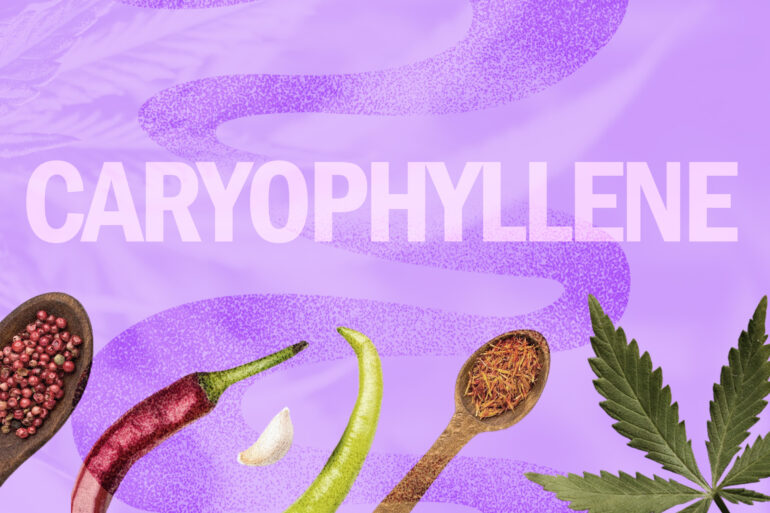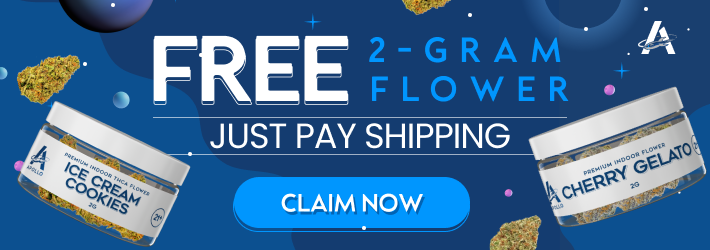Key Takeaways:
- Beta-caryophyllene is a commonly dominant terpene in Cannabis, and dietary cannabinoid in herbs and spices like black pepper and basil.
- Beta-caryophyllene gives a familiar spicy and peppery aroma and may have potent therapeutic effects for relieving pain, inflammation, anxiety, depression, and more.
- Fun fact: Beta-caryophyllene is uniquely considered a non-intoxicating, dietary cannabinoid due to its abundance and selective, anti-inflammatory CB2 receptor actions.
Characteristics of Beta-Caryophyllene
Beta-caryophyllene is one of the most common terpenes in Cannabis and beyond.
Plants make several kinds of caryophyllene that serve defensive functions. Caryophyllene wards off insects that eat plants, while also attracting predatory bugs that eat herbivorous bugs.
For humans, the caryophyllene of most research and therapeutic interest is the abundant beta type. Beta-caryophyllene is behind the spicy and peppery scents of a plethora of herbs and spices including:
- Black pepper
- Basil
- Rosemary
- Oregano
- Hops
- Clove oil
- Cinnamon
- Caraway
- Grains of paradise
When cannabis is heated enough to decarboxylate cannabinoids, terpenes like beta-caryophyllene are also decarbed and oxidized. Caryophyllene oxide gives a scent more like lemon balm and has antifungal and insecticidal properties. It’s also detectable by drug-sniffing dogs.
Cannabis Strains High in Beta-Caryophyllene
When studies sample chemovars, or strains, beta-caryophyllene is almost always one of the most abundant terpenes in the majority of samples. In fact, it’s the most common sesquiterpene (15-carbon terpene) in Cannabis.
Basically, this means you won’t have a hard time finding it in most chemovars. In particular, Caryodiol™, aka Kashmir Blue, is a special strain known for its selectively high beta-caryophyllene and CBD content – and is even named after both!
Other noteworthy cannabis strains that are rich in beta-caryophyllene include:
- SFV OG
- Super Lemon Haze
- Lemon Skunk
- Afghan Kush
- Blue Cheese
- Chocolope
- CBD Skunk Haze
- White Widow
- Purple No. 1
- Durban Poison
- Glueberry OG
- Blue Berry
- Black Berry Kush
- Purple Kush
- CBD Charlotte’s Angel
- Meringue
- Bubba Island Kush
- And many more
Effects: What Does Beta-Caryophyllene Do?
Beta-caryophyllene is a dietary cannabinoid that doesn’t get you high.
New research shows some terpenes may activate CB1 to increase highs – but not caryophyllene.
Instead, small clinical and mostly preclinical data show beta-caryophyllene hits other targets that may symptomatically relieve:
- Anxiety
- Depression
- Stress
- Pain
Therapeutic Benefits
Beta-caryophyllene has a key strategic advantage because of its uniquely strong CB2 functions, without CB1 intoxication.
In addition to the above, this unlocks a wider range of potential therapeutic effects for:
- Inflammation
- Addiction (Cocaine, Alcohol, Nicotine, Opioids, Food)
- Atherosclerosis
- Chronic and fatty liver diseases
- Osteoarthritis
- Osteoporosis
- Diabetes
- Epilepsy
- DOMS
- Nausea
- Gastroprotection
- Neuroprotection
- Antimalarial
- Antifungal
- Antibacterial
- Anticancer
- Chemosynergy
Side Effects
Natural beta-caryophyllene is generally safe and approved as a food, taste, flavor, and cosmetic additive by the FDA.
There are a handful of direct clinical studies examining beta-caryophyllene effects in humans that support its safety and well-tolerability.
Earlier animal studies also show mice can tolerate doses as high as 2,000 mg/kg without side effects. Beta-caryophyllene does not appear to affect weight, appetite, water intake, blood pressure, or other biological measurements in humans or animals.
Related:
References
- Al-Khazaleh, A. K., Zhou, X., Bhuyan, D. J., Münch, G. W., Al-Dalabeeh, E. A., Jaye, K., & Chang, D. (2024). The Neurotherapeutic Arsenal in Cannabis sativa: Insights into Anti-Neuroinflammatory and Neuroprotective Activity and Potential Entourage Effects. Molecules, 29(2), Article 2. https://doi.org/10.3390/molecules29020410
- Barré, T., Di Marzo, V., Marcellin, F., Burra, P., & Carrieri, P. (2023). Expanding Research on Cannabis-Based Medicines for Liver Steatosis: A Low-Risk High-Reward Way Out of the Present Deadlock? Cannabis and Cannabinoid Research, 8(1), 5–11. https://doi.org/10.1089/can.2022.0014
- Benavides, A. (2022, June 23). Beta-Caryophyllene—Terpenes and Cannabinoid Research—Cannakeys. https://cannakeys.com/beta-caryophyllene-terpene-research/
- Cox-Georgian, D., Ramadoss, N., Dona, C., & Basu, C. (2019). Therapeutic and Medicinal Uses of Terpenes. Medicinal Plants, 333–359. https://doi.org/10.1007/978-3-030-31269-5_15
- de Cássia da Silveira e Sá, R., Lima, T. C., da Nóbrega, F. R., de Brito, A. E. M., & de Sousa, D. P. (2017). Analgesic-Like Activity of Essential Oil Constituents: An Update. International Journal of Molecular Sciences, 18(12), 2392. https://doi.org/10.3390/ijms18122392
- Liktor-Busa, E., Keresztes, A., LaVigne, J., Streicher, J. M., & Largent-Milnes, T. M. (2021). Analgesic Potential of Terpenes Derived from Cannabis sativa. Pharmacological Reviews, 73(4), 1269–1297. https://doi.org/10.1124/pharmrev.120.000046
- Oliveira, G. L. da S., Machado, K. C., Machado, K. C., da Silva, A. P. dos S. C. L., Feitosa, C. M., & de Castro Almeida, F. R. (2018). Non-clinical toxicity of β-caryophyllene, a dietary cannabinoid: Absence of adverse effects in female Swiss mice. Regulatory Toxicology and Pharmacology, 92, 338–346. https://doi.org/10.1016/j.yrtph.2017.12.013
- Peters, E. N., Yardley, H., Harrison, A., Eglit, G. M. L., Antonio, J., Turcotte, C., & Bonn-Miller, M. O. (2023). A randomized, double-blind, placebo-controlled, repeated-dose pilot study of the safety, tolerability, and preliminary effects of a cannabidiol (CBD)- and cannabigerol (CBG)-based beverage powder to support recovery from delayed onset muscle soreness (DOMS). Journal of the International Society of Sports Nutrition, 20(1), 2280113. https://doi.org/10.1080/15502783.2023.2280113
- Raz, N., Eyal, A. M., Zeitouni, D. B., Hen-Shoval, D., Davidson, E. M., Danieli, A., Tauber, M., & Ben-Chaim, Y. (2023). Selected cannabis terpenes synergize with THC to produce increased CB1 receptor activation. Biochemical Pharmacology, 212, 115548. https://doi.org/10.1016/j.bcp.2023.115548
- Russo, E. B. (2011). Taming THC: Potential cannabis synergy and phytocannabinoid-terpenoid entourage effects. British Journal of Pharmacology, 163(7), 1344–1364. https://doi.org/10.1111/j.1476-5381.2011.01238.x
- Russo, E. B. (2019). The Case for the Entourage Effect and Conventional Breeding of Clinical Cannabis: No “Strain,” No Gain. Frontiers in Plant Science, 9. https://doi.org/10.3389/fpls.2018.01969
- Siracusa, L., Ruberto, G., & Cristino, L. (2023). Recent Research on Cannabis sativa L.: Phytochemistry, New Matrices, Cultivation Techniques, and Recent Updates on Its Brain-Related Effects (2018–2023). Molecules, 28(8), 3387. https://doi.org/10.3390/molecules28083387
- Sommano, S. R., Chittasupho, C., Ruksiriwanich, W., & Jantrawut, P. (2020). The Cannabis Terpenes. Molecules, 25(24), 5792. https://doi.org/10.3390/molecules25245792
- Surendran, S., Qassadi, F., Surendran, G., Lilley, D., & Heinrich, M. (2021). Myrcene—What Are the Potential Health Benefits of This Flavouring and Aroma Agent? Frontiers in Nutrition, 8. https://doi.org/10.3389/fnut.2021.699666
- Tomko, A. M., Whynot, E. G., Ellis, L. D., & Dupré, D. J. (2020). Anti-Cancer Potential of Cannabinoids, Terpenes, and Flavonoids Present in Cannabis. Cancers, 12(7), 1985. https://doi.org/10.3390/cancers12071985
- Weston-Green, K., Clunas, H., & Jimenez Naranjo, C. (2021). A Review of the Potential Use of Pinene and Linalool as Terpene-Based Medicines for Brain Health: Discovering Novel Therapeutics in the Flavours and Fragrances of Cannabis. Frontiers in Psychiatry, 12, 583211. https://doi.org/10.3389/fpsyt.2021.583211
- Wróblewska-Łuczka, P., Cabaj, J., Bargieł, J., & Łuszczki, J. J. (2023). Anticancer effect of terpenes: Focus on malignant melanoma. Pharmacological Reports, 75(5), 1115–1125. https://doi.org/10.1007/s43440-023-00512-1

